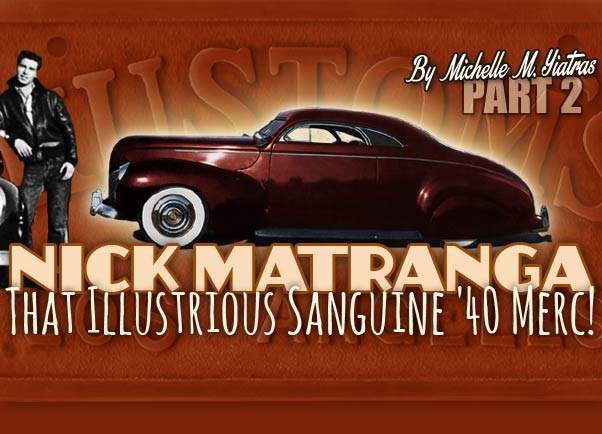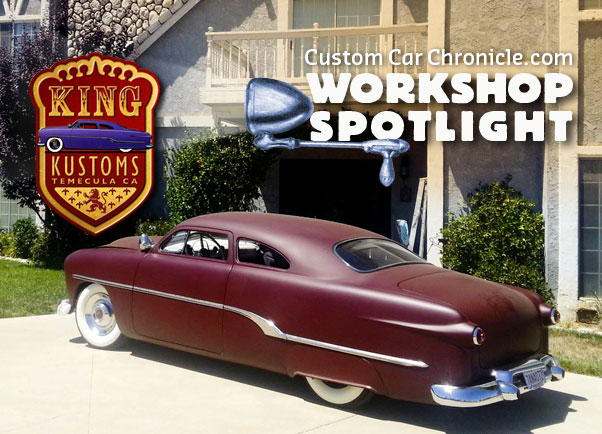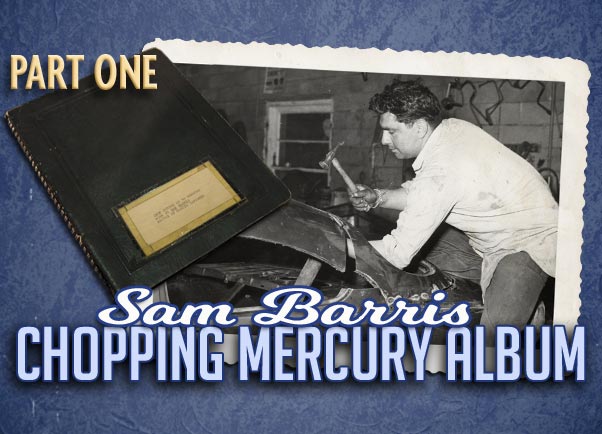That Illustrious Sanguine 1940 Merc 2
© by Michelle M. Yiatras Timechanic ™
(Nick Matranga – That Illustrious Sanguine ’40 Merc! – original written February, 2014)

Part two
Due to the length of this article from Michelle, we have split it up in three parts. Be sure to click “NEXT PART” at the end of this article to see the full article.
David Zivot on Nick and his Merc
So…Why another Matranga Merc? “It isn’t just another one. We don’t need just another one. That automobile was an amalgamation of the thought processes of Nick Matranga, Sam Barris, and George Barris. Nick related to me, while inspired by the J. Zaro and A. Andril Mercury’s, he wanted something more advanced and stylish that would set his ’40 Mercury coupe apart from more common customs he saw around L.A. There were other ’40 Merc coupes running around then and none met Nick’s sense of style. As a high school kid in 1948 L.A. he was influenced by pillarless hardtops like the ’49 Buick Roadmaster Riviera, the ’49 Cad Coupe de Ville, and the ’49 Olds Holiday. I saw enough Matranga-style attempts in mags and at shows, and I was a bit disappointed in the lack of commitment in trying to achieve an accurate rendition. Not that accuracy was necessarily the goal of some of these builders. But Nick was clearly chagrined that no one quite ‘got it right’.

Nick and I discussed the inexhaustible popularity and emulation that his senior year project provided custom car guys through the years. He actually had plans to replicate his most memorable car himself. Nick was very polite to other builders, and often autographed their visors and dashboards, but was let down by the missing verisimilitude of most that he viewed. Then I presented him that with his help and advisement I’d take a shot at it. I took extraordinary efforts and pains to assure it would be as accurate and true to nature as humanly possible. He took an immediate interest because he observed my authenticity for historical and technical concerns.
He’d say, ‘How the hell did you know that? I haven’t thought about that in 50 years!’ Nick was a consummate gentleman, well-mannered and well-informed. If I asked a question and he didn’t know the answer on the spot, a week later I’d get handwritten letters in his perfect penmanship, ‘Now I remember how I did that…’ We talked about more than his iconic car; we talked about J.C. Fremont High School, his neighborhood, the drive-ins, hanging out at George’s and Sam’s place. How it was the best being a teenager in L.A. in the 1940’s. And all the really neat cars you’d see driving around every day, very well done customs and hot rods, and not as well done but sincere efforts. It was fun and the weather permitted. He told me they’d go downtown and see Gary Cooper or Clark Gable coming out of Eastern Auto or Musso & Frank Grill or a men’s clothing store. Also he mentioned some of his relatives in charge of L.A.-based back-east interests, like restaurants and bars. They’d pick up the check for him and his friends so he could act like a big shot.
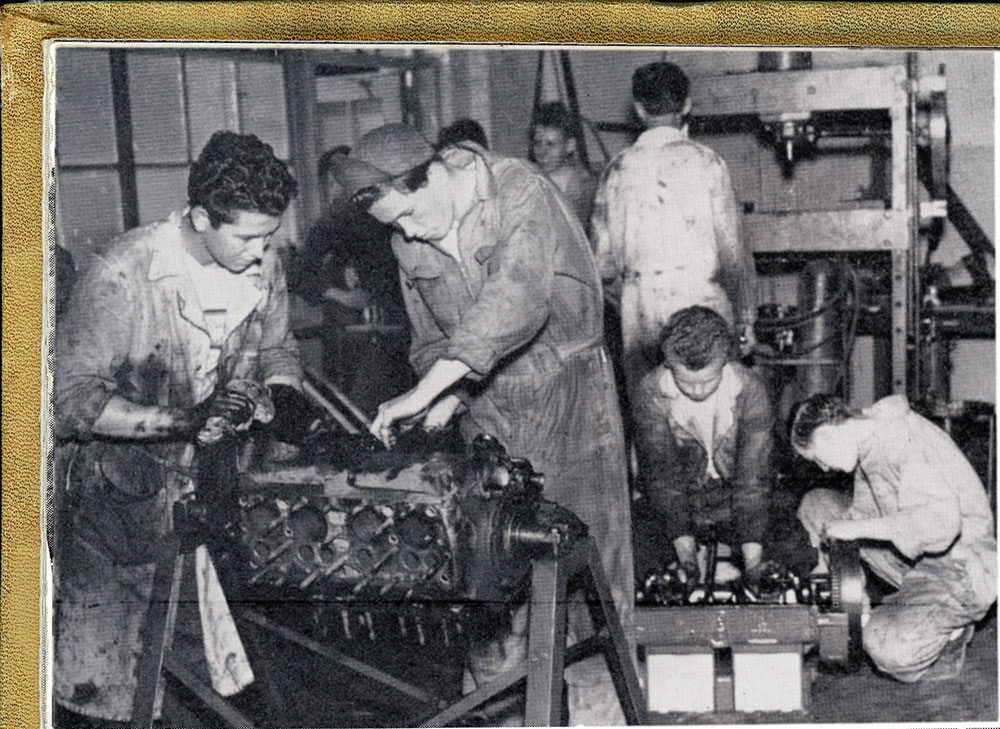 Nick at the High School Senior Autoshop L Fremont ’48.
Nick at the High School Senior Autoshop L Fremont ’48.
[divider]
 Nick High School Senior Football Letterman Fremont ’48 Back Row 2nd fr L from Nick’s 1948 Fremont High School senior yearbook, gifted to David & Michelle.
Nick High School Senior Football Letterman Fremont ’48 Back Row 2nd fr L from Nick’s 1948 Fremont High School senior yearbook, gifted to David & Michelle.
[divider]
I’m a proponent of a high degree of exactitude in representing an automotive artifact. The original car existed a brief couple of years. It’s important to have a representation that would exemplify Nick, as well as Sam and George, and the time period. Nick said if you were a good-looking guy and had a keen car you had no trouble for Fri and Sat night dates, and you could just be driving down the street and girls would jump in your car. As a teen you have a lot less cares and concentrate on the important things like cars, hamburgers, and skirts. Nick said if he hadn’t gone to Korea, he woulda really had a good time in his car, but the time he did have was too short.”
“George’s Greek aesthetics of color and form were amazing and unfailing,
especially early on.”
Technical regards… “He’d seen other Barris lacquer jobs, including George’s own car, that had the deep majestic maroon that George would conjure up by using toners and custom blends that he would supervise at the paint store. George’s Greek aesthetics of color and form were amazing and unfailing, especially early on. Nick thought that patrician maroon stood out and glowed on the street, particularly at night under the street lights. Nick knew what he wanted in his mind, Sam knew what he wanted in his mind, and when they started cutting the roof they arrived at, ‘That’s it!’ Both Sam and Nick agreed that the flow of the roof, at the sail panels, a product of CA metal shaping, the raised windshield header area, and other refinements, and the most important omission of cumbersome B pillars, were much more advanced and pleasing developments than what was done on the Zaro or Andril cars. Nick was adamant about these things. Phil Weiand built and modified Nick’s ’46 Mercury block, with full Weiand racing equipment, and Winfield cam, and took special care in its assembly and cosmetic appearance. Nick wanted it sound with plenty of pep for street reliability.”

Examining the ‘Kustom’s L.A.’ club plaque. “Hmmm…Color photographs of a ‘Kustom’s L.A.’ plaque, that’s neat. And also serves to confirm that they were most likely royal purple, as the contrast between the California black plate and the deteriorating Ektachrome or Kodachrome photographic print would tend to distort the true color. The photo of the aluminum plaque on Jim Skonzakes’ ’49 Buick is clearly purple. Refer to the back of the photo, July 22, 1952, #12, dated.
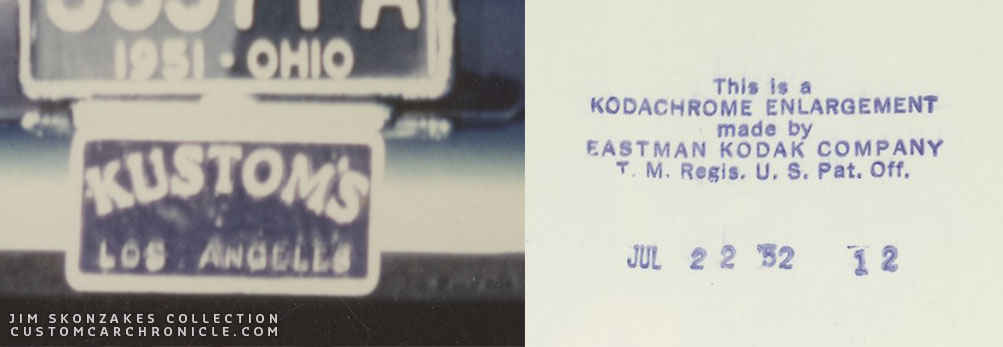 Color photo from Jul 22, 1952 of Jim Skonzakes his 1949 Buick shows what looks like an aluminum Kustom’s plaque with a purple painted base.
Color photo from Jul 22, 1952 of Jim Skonzakes his 1949 Buick shows what looks like an aluminum Kustom’s plaque with a purple painted base.[divider]
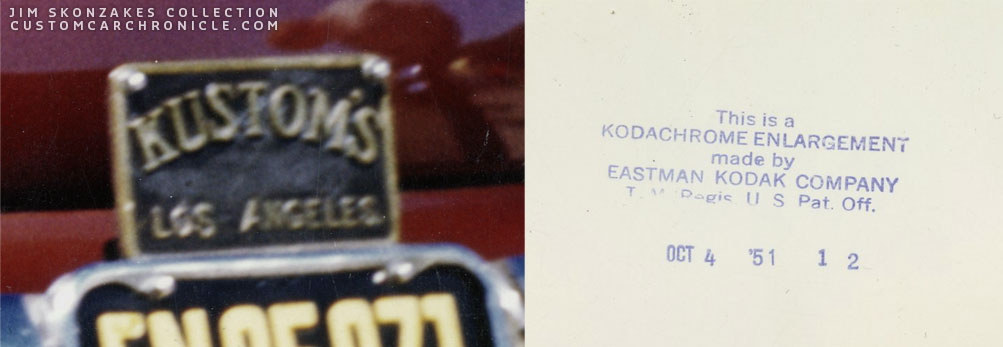 Color photo from Oct 4, 1951 shows a brass Kustom’s Plaqueon on the Jack Stewart 1941 Ford with what appears to be a black painted base.
Color photo from Oct 4, 1951 shows a brass Kustom’s Plaqueon on the Jack Stewart 1941 Ford with what appears to be a black painted base.[divider]
The original plaque that I am in possession of, which was gifted to me from Nick Matranga a few years ago, has a numeral ‘3’ stamped into the back. It measures X” W x X” H x X” thick. The recast that Kurt McCormick makes measures X” x X” and varies in thickness between X” and X”. All early originals, let’s say the first twelve to fifteen, were cast art bronze, and had the telltale large ‘S’ at the end of ‘LoS’. Jesse Lopez was the first President of ‘Kustom’s L.A.’, and was instrumental in its formation in 1948. The plaque that Nick gave me is his original off the ’40. He got an additional plaque when he came back stateside in 1953, when the Korean War ended. He purchased a brand new ’53 Mercury Monterey two-door hard top, on which he attached the plaque. He could not remember who gave it to him, but I have an idea that all the original members were given a number as to when they joined up or when the club was formed. Just a theory.
 Nick’s Original Kustom’s L.A. Plaque; this was Nick’s original that was emblazoned on the ’40 Merc, also ran on the ’53 Mercury Monterey, gifted to David.
Nick’s Original Kustom’s L.A. Plaque; this was Nick’s original that was emblazoned on the ’40 Merc, also ran on the ’53 Mercury Monterey, gifted to David.[divider]
As to the aluminum one at the NHRA museum, I wouldn’t discount it out of hand. I know a fellow in Los Angeles who’s had an aluminum version of this plaque since 1952. George Barris had an affinity for Greek nobility and the trappings of royalty, that’s why he favored purple and the royal coat of arms that he fabricated for the affected Barris crest. It’s a Greek thing. In the realm of small details, notice the pair of ‘Kustom’s L.A.’ club plaques that have been removed from Nick’s car and probably Johnny Zaro’s that are stacked together in Nick’s booth at the 1951 Oakland Show. They are leaned up against the wood divider in front of Nick’s car right by the hacksaw that’s lying on the ground. One of these days one of us will spot an ethereal image of Mother Mary in the ripples of a lacquer paint job.”
 Two Kustom’s plaques are up against the divider wall with Nick’s Mercury on the left. (the full photo can be seen in part one)
Two Kustom’s plaques are up against the divider wall with Nick’s Mercury on the left. (the full photo can be seen in part one)[divider]
Tony Pisano of the Pisano Brothers, on Nick
Joe and Carmen Pisano, Tony and Frank’s oldest brothers, were family tight with Nick, like Nick was another brother. Tony Pisano, of the Pisano Brothers, who built the Pisano/Ogden ’41 Buick chopped custom with an original Gaylord Carson top, was a drag racer. He owns ‘Worco Powder Coatings’ on Cherry Industrial Circle, in Long Beach, CA. “I was in the scroungy war, when we were all into putting together the cars in different combinations. I was drafted into the Army. Nick was pals with my brother, Carmen. They met at the drive-ins and shops. Carmen hopped up some of his engines. Nick’s dad had a night club, ‘The Mint Tulip’, on Florence near Normandy. The memories are sad because it hurts to remember. Nick had a hot-headed sense of humor. He could be critical. Nick was a good-looking guy, he had all sorts of broads. Nick was a fun guy, he could walk by a woman and say, ‘Wow, what a great ass!’, and they would say, ‘Thanks for the compliment.’ He was likeable and could get away with it.”
Frank Pisano of the Pisano Brothers, on Nick
Born in 1939, and native to L.A., owns ‘Venolia Pistons and Rods’ on Cherry Industrial Circle, in L.B., CA. “Nick came over to Tony’s ‘Worco Powder Coatings’ every Saturday to have his ’37 Chevy powder coated. We all hung out and ate at ‘Curley’s Cafe’ for hamburgers. When I first started driving my funny car ’67 Camaro at Lion’s Drags in 1968, Nick made sure I was seat belted tight in before I got to the starting line. He’d close the door and pat me on my head. He had the side windows made right specially for me out of plastic. He hung out with my older brothers, Joe, Carmen, Tony, Sammy, and me the brat. He’d always go to the races with us to make sure everything was OK. Nick was that type of guy, loving. More than a friend. We were there for each other and helped in each other’s businesses. Carmen supervised setting up the car racks at Nick’s transmission shop. Tony painted and powder coated for Nick. If we needed a transmission done he took care of it. When you’re Italian you trade. We didn’t exchange money.
Nick in his days was a good-looking guy, always well dressed. And he didn’t like to get dirty
I first met Nick about 10 years old. My brothers brought him over to the shop, on 52nd and Western in L.A., ‘Bigelo & Pisano’. Carmen was the smart one, our leader. Joe was the car salesman. Tony was the painter. Sammy was a general contractor. I was the mechanic helper. I helped with the race cars. Nick in his days was a good-looking guy, always well dressed. And he didn’t like to get dirty. You look at him and he would talk to you, and he was very nice looking and very nice person, and you wondered if he was a gigolo. When I got to know more of him I learned he was a very true and honest man. If he didn’t like you he’d let you know about it. If he did like you he’d give his heart to you.
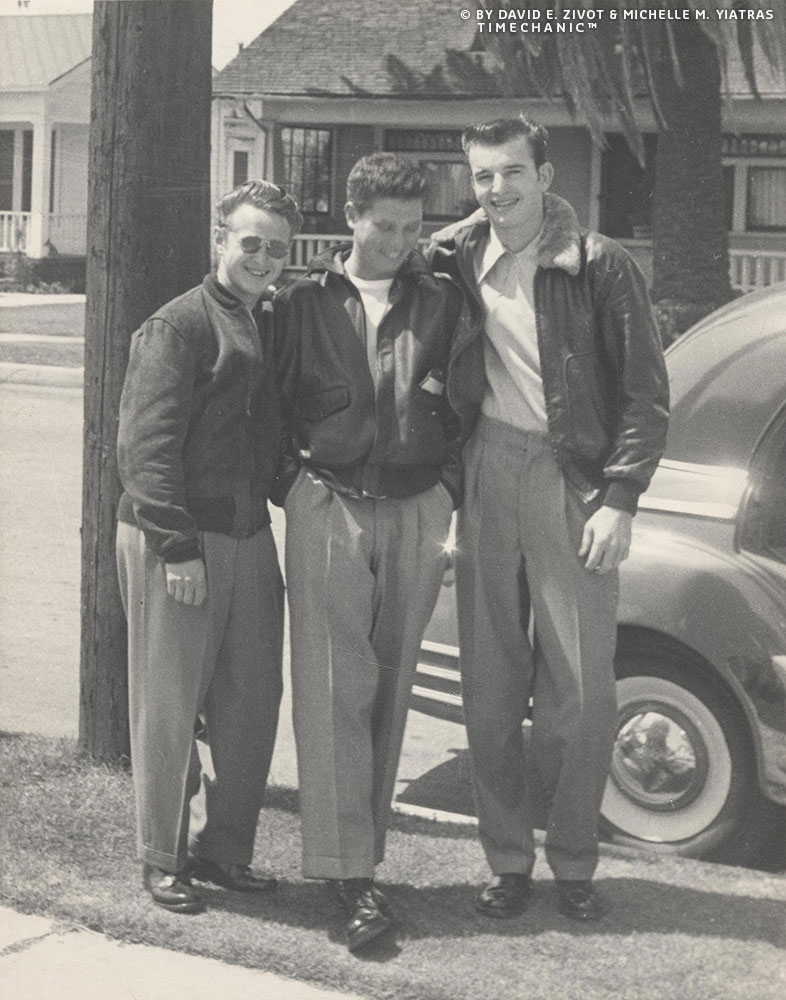 Nick in the middle and good friend James Mahaffey on the right in 1947.
Nick in the middle and good friend James Mahaffey on the right in 1947.[divider]
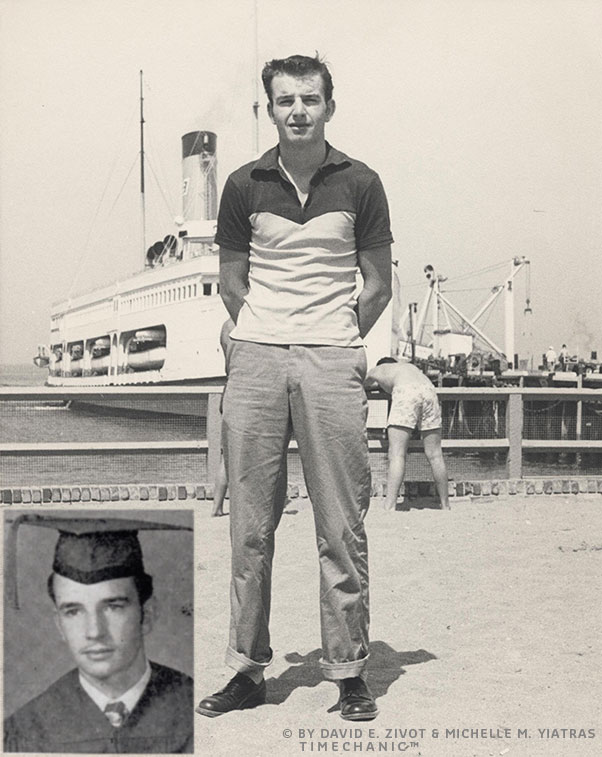 James Mahaffey at Catalina Island 1947 & Fremont High Senior Grad ‘48”; Jim Mahaffey got killed making a pass and upset in his ’32 coupe at Russetta sanctioned El Mirage dry lakes in 1947 at 17 years old, erased but not to be forgotten on the speed record chalkboards; from Nick’s personal collection, including an insert from Nick’s 1948 Fremont High School senior yearbook, gifted to David & Michelle.
James Mahaffey at Catalina Island 1947 & Fremont High Senior Grad ‘48”; Jim Mahaffey got killed making a pass and upset in his ’32 coupe at Russetta sanctioned El Mirage dry lakes in 1947 at 17 years old, erased but not to be forgotten on the speed record chalkboards; from Nick’s personal collection, including an insert from Nick’s 1948 Fremont High School senior yearbook, gifted to David & Michelle.[divider]
They all allowed me to hang out with them. They’d say, See you at the drive-in, ‘Scrivener’s’ in Inglewood. We’d have coffee and hook up to race. We’d park in the back and talk about our cars, motors, and chops. I started driving at 13, not supposed to without a license. ’53 Studebaker trucks with Cad motors. After Korea in the ‘Screwdrivers’ club of Culver City, with my brother, Joe, and Don Rackemann and Nick. I rode with my brothers while street racing between Culver City and Inglewood. On 190th in Inglewood was a root beer drive-in that we met at to race. As fast as you could go, and whoever was way ahead would shut off because the other guys couldn’t catch him. There was no measured stretch. We had so many cars that we moved around and changed around, ’32 roadsters, Model A coupes, and Chevy coupes, 32’s-33’s-34’s, and later ’55 and ’57 Chevy’s. Before Korea we mostly worked at our race shop. It was a gathering and BS place. We always had black cars. Nick said it was important to keep it clean and polished.
He always hugged me and said I was doing the right thing by keeping ‘Venolia Pistons’ going when Joe died. Joe died in my arms at the races from a heart blockage. I took care of my mother and father when they were sick, like Nick took care of his wife and son. We always stuck together. We all had our shops on the same street on the Cherry Industrial Circle in L.B., and that was our later hang out.”
 Russell Lenarz High School Senior Fremont ’48”; the elusive hot rod racing photog in composite from Nick’s 1948 Fremont High School senior yearbook, gifted to David & Michelle. Russell Lenarz took the ‘Jesse & ’41 Ford 1949 Turf Club’ photo, and so many others.
Russell Lenarz High School Senior Fremont ’48”; the elusive hot rod racing photog in composite from Nick’s 1948 Fremont High School senior yearbook, gifted to David & Michelle. Russell Lenarz took the ‘Jesse & ’41 Ford 1949 Turf Club’ photo, and so many others.
[divider]
Herschel ‘Junior’ Conway, ‘Junior’s House of Color’, of Florence Av, Bell Gardens, CA, on Nick
“I was the youngest kid working at Barris’. I met Jesse in 1955. Jesse came around a lot more than Nick did. Nick already got rid of his Merc and was back from Korea by the time I met him. Even the 1960’s had passed by the time I really got to know him, even though in the early 60’s he talked to me about painting a ’57 Chevy Nomad black. I was wary, I had plenty of business, and knew he was very particular. I knew Jesse and Hirohata well. Nick and I didn’t hook up until the 1970’s. He took the Nomad to Barris’ to have Tubs paint it. And he wasn’t happy that the job wasn’t detailed enough for him. He called to tell me about it. I passed. Then he sold the Nomad, and later in the 1970’s went to build a ’32 Ford coupe.
 Nick’s Barris shop painted 1957 Chevy Nomad.
Nick’s Barris shop painted 1957 Chevy Nomad.
[divider]
He had Barris’ doing body work, his guy Dick Dean. One day he called me up to inspect some parts and redo some body work. Next I was doing all the rest of the bodywork on it. I was doing high end sports car work (Ferrari, Lamborghini, Maserati, Rolls), and he liked how I finished, fit, and detailed cars. We’re in the process of bringing it to paint. It cost a lot, so he had Boyd Coddington paint his ’32 in the early 1980’s.
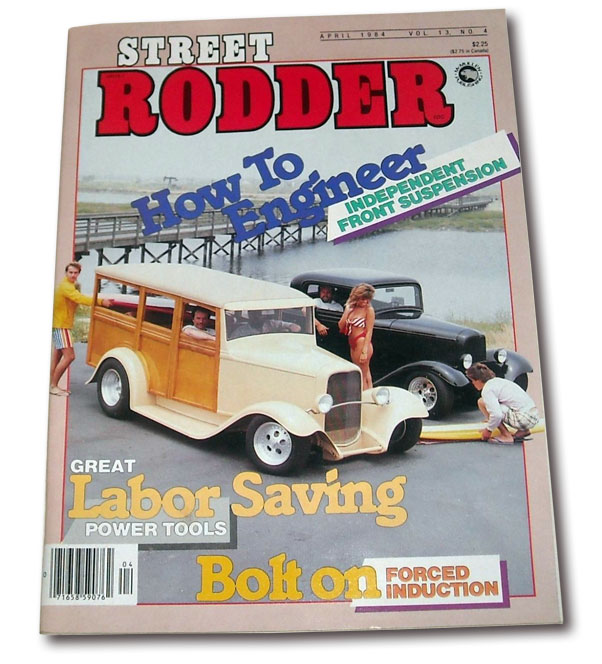 Nick’s black 1932 Ford coupe, painted by Hot Rods by Boyds made it onto the cover of the April 1984 issue of Street Rodder magazine.
Nick’s black 1932 Ford coupe, painted by Hot Rods by Boyds made it onto the cover of the April 1984 issue of Street Rodder magazine.
[divider]
I’d go visit him and have him do transmission work and he’d visit me. He’d say, ‘You are the best painter, at everything you do, your detail finish work, you’re just too expensive.’ I had too much work to do, and Nick always wanted a deal. To do the custom work today to my level is very expensive. I can’t give a guy that kind of work and keep it affordable. A lot of guys are running into that. In the early days, I didn’t plan it. I made the car and we all traded out. That is the only way those cars got done. Jesse and Nick both worked two, three jobs to afford their cars, materials alone.
Today’s kids read a magazine or see a TV show and think it’s easy. I was a young boy that came from Kentucky in 1952, and I too read the mags and wondered how they afforded to do this. I questioned how Jesse and Nick had the money to spend. When I got here I realized it was a lot of bargaining and horse trading to get it done. I had Sam black out my bumpers so the bolts didn’t show through, and he leaded the hood so it didn’t have chrome molding anymore. It took him two full nights. It took me two weeks of painting his house trim to work off that trade. George wanted to include my car in a car show with others. He needed it finished so he took money out of my paycheck to pay for the labor a whole year after George and I finished my car, my senior year of high school, 1956-57. Had it not been for people like George and Sam Barris, at any shop, if not for being able to work on your car in the facilities that they had, and shared with you, the expense would not have been possible. I was very young, younger than the rest. Seventeen when that car was finished and in shows, thanks to them. I worked for Barris until 1961. By 1960 Jesse and I did ‘House of Color’, until I took it entirely over in 1961, ‘Junior’s House of Color’.” Junior’s ’50 Ford business coupe custom, painted ‘Sam Bronze’, went away by 1970, and was accurately rebuilt by Jerry Daman of Dallas, TX, who is also rebuilding the Jesse Lopez ’41 Ford club coupe custom.
Don Rackemann of San Pedro, CA, on Nick
Lifelong best friend of Nick’s. Ran Saugus Dragstrip. Lou Baney and Lou Senter owned Saugus, Don ran as manager and starter 1951-55. Owned ‘Don’s Speed Shop’ 1950-52, with partner Lou Baney, running at lakes and building hot engines. Changed to ‘Lou Baney Automotive’ when he sold him his share. From 1952-55 went on as ‘Ansen Automotive’ representing after-market hot rod parts to speed shops. Now owns ‘Fuel Savers Group’ MPG3 fuel enhancer. “I knew Nick since junior high. We went to different junior highs, and then later went to John C. Fremont High School. We were both small guys in the 10th grade, 15 years old, maybe 100 lbs, 5’2”. But we thought we were cool. We got in an argument and a fist fight in the quad. We were hitting each other and not doing any damage because of our small size. The other kids looking on were stunned. We weren’t even aware until the coach pulled us apart and told us we were making a spectacle of ourselves. We stayed friends. At 16 on California nights all year round us hot rodders went to the drive-ins: ‘The Wich Stand’ on Slauson by W. LA and Inglewood; ‘Scrivener’s’ on Manchester Blvd in Inglewood; ‘DeMay’s’ on Slauson in Culver City. We’d cross paths. Then for a year we didn’t.

In the meantime I built a ’32 three-window coupe in stock brown-black, sitting on the corner of Hoover, and the car next to me is the primered Merc, and it’s Nick smiling at me. ‘Nick! What are doing on that lead barge?’ At that time Jesse was building his car at Barris’, I was a hot rodder, not a customizer, and I had to show him how the cookie crumbles. I revved the engine to let him know I had the horsepower. He scrunched his head and declined because he had a stock engine in it still. So I hit the throttle and went on down the road, 60-80-100 mph, in 1949. Nick’s car took a lot longer to complete than my coupe. I put my car in the hot rod show at the L.A. Armory 2nd show 1951. I took first place in the competition coupe class they put me in. A man came into the show on Saturday with his son. They went gaga and wanted to buy it. I hesitated because I just finished the paint and upholstery. Next day on Sunday he came back and offered me $100, so I took it and sold it at the show. A Merc bore, stock stroke, Offenhauser heads and manifold, three Strom 97 carbs, stock ignition, Iskenderian ground cams. Stock good street machine. Only engine I ran in it. It taught me a big lesson.
 Don Rackemann’s 1932 Ford Coupe at an early 1950’s Motorama show. The photo was taken by Walter Wyss and is part of the Jimmy Barter Collection (Thank you for sharing it with us Jimmy).
Don Rackemann’s 1932 Ford Coupe at an early 1950’s Motorama show. The photo was taken by Walter Wyss and is part of the Jimmy Barter Collection (Thank you for sharing it with us Jimmy).
[divider]
 Nick (rear L) & Pals in ’25 T Track Roadster 1947.
Nick (rear L) & Pals in ’25 T Track Roadster 1947.
[divider]
Some guys had exotic stroker engines. My car ran so strong. It had Lincoln gears in the transmission, a longer 25 tooth cluster gear, 4:11’s rear end, 6.00 x 16 on the front. Without planning it, that combination with the compression, and the cam, and the carburetion, ran really fast with the gear ratios. I sold that car and opened up a first shop with that money, ‘Don’s Automotive’, located kitty corner from ‘Scrivener’s’ on Slauson and Western in S.W. L.A., 1951. I built engines for my friends who wanted to go fast. The first drag race at Santa Ana, 1950, before the Armory show, I raced that ’32 coupe, rolling start quarter mile, and won first place coupe and sedan class. Beat Joe Reath in the semifinals, and Dean Moon in the finals.
 Clark Gable & his 1949 Jaguar XK120 Roadster ‘Gable Grey.
Clark Gable & his 1949 Jaguar XK120 Roadster ‘Gable Grey.
[divider]
I still had the ’32 coupe and my wife was still pregnant. We were driving out to Malibu. I just finished the engine and it was all clean and chromed, putting some miles on it. Winding along the 101, on our way back through Encino, I glanced to the left and going opposite I noticed the new green Jaguar go by, and realized it was Clark Gable. I whipped a U-turn and caught up with him at a signal. He glanced over at my engine and raised his eyebrows. I revved my engine a couple times. So he smiled. He reached over to put his in low gear and then the signal changed. He jumped on it. My car with those gears I could run 70 mph in low gear. I just stayed right beside. He bangs his shift into second and I still stayed right beside him. He smacked it into third gear, I jumped on the throttle, put mine into second, and smoked his ass. I had to shut it off for the next signal. Then he pulled up next to me at the signal, and smiled and said, ‘Pretty fast, son, pretty fast.’ I was twenty years old. Sue, my first wife, just giggled. Nick and I were the same age, born the same year.
After the ’32 three-window was sold and I opened my shop, 1951, Nick went into the Army. When he came home, the first thing he did was call me and said, ‘I hear you have a really, really hot coupe!’ I said, ‘I’ll pick you up at 7 o’clock!’ He looks it over and says, ‘Aw, this is bitchin’.’ We went to ‘DeMay’s’ drive-in. There were a couple guys and cars we didn’t know. He says, ‘Is there anything here you can’t beat?’ I said, ‘No.’ So he says ‘How about that guy that just pulled in?’ A ’32 roadster. Nick walks over to him and says, ‘You wanna try it?’ ‘Yeah sure,’ thought his roadster could beat my coupe. We went to Lincoln Blvd, behind L.A. International Airport. The runways were so long and Lincoln stretched diagonally across that back of the airport. Nick said, ‘Where do you want me to get out?’ to drop him off while I ran the race. I said I can’t because the floorboards that were angled had screw down bolts. Mine fit real tight so I didn’t put the screw in, and I put carpet over them. So I would have someone sit next to me and put their feet down on them and hold them when the car went over 100-110 mph. So he had to ride the race with me a lot to hold the floor boards down, at least three times a week going street racing. He already sold the Merc.
From the late 1940’s-50’s, to the early 1960’s, Nick’s dad, Nick Sr, had a family Italian restaurant named ‘Nick’s’, on Florence Av in L.A. I ate dinner, mostaccioli and spaghetti, many times. We’d end up there before racing. Later in 1958, after I got Nick to quit laying bricks and come be the vice-president of my company, ‘National Bonded Cars’, the first company to ever put out a mechanical failure warranty on used cars. Jack Hershey also worked for me in sales. Nick’s first wife, Gayleen, and my wife of 60+ years, Jo, were friends. Nick’s brother-in-law Larry, and my wife’s brother Jon, were also real good friends. They figured out a system to make money in Las Vegas. They showed it to us, and we acted like it was nothing. Jack Hershey, who was our pal, got me and Nick to practice this dice rolling system on the living room floor, and it worked! We said, ‘Let’s go to Vegas,’ and the three of us went. Jack writing the pad, I’m working the money, and Nick’s watching the action. The first weekend we went we each put up $150 in the pot for the bankroll. At the end of the weekend we came home with $3600 each. We stayed at the Sahara Hotel because Louis Prima and Keely Smith were headlining. We really thought we were hot stuff, big time gamblers. We drove a white 1957 Cadillac Coupe de Ville. Next week we flew and did the same. It started out ahead, and then it turned and we lost everything. We called our wives to wire another $450. We lost again. They’re mad, we’re mad. On the plane home we’re not even talking to each other. I had just purchased, as the owner, the company ‘National Bonded Cars’. So we got home Sunday night. On Thursday I got my first commission check $2000+. We took that check and got back on the plane to Vegas. Hershey had the paperwork from the other runs, I put up the money. This time we won $36,000 ($12,000 apiece). This time we had a bankroll that kept us going to win. Our system worked.
 The ’29 roadster on a ’32 frame was painted Iris Blue, and striped and flamed by Von Dutch.
The ’29 roadster on a ’32 frame was painted Iris Blue, and striped and flamed by Von Dutch.
[divider]
At 1955 Bonneville, the ‘Iris’ light blue color, it was very subtle and really stood out with the Von Dutch red, yellow, and orange flames. Lou Baney was service manager over all three Yeakel Brothers; Cadillac, Olds, and Chrysler-Plymouth. We were sponsored by Yeakel Cad. That year of 1955 the ‘Iris Blue’ Cadillac was their prime chip color. I had all the embroidered shirts and painted vehicles in that color. Nick put up the money for the second engine that we built and won the records, that was Nick’s engine. Us hot dogs (Nick Arias Jr, Lou Baney, Teddy Evosavich, Bill Likes, Nick Matranga, Danny O’Brien, Don & Rich Rackemann, Don’s wife Jo) had Nick Arias’ Jimmy in the car the first couple days. Nick M.’s stroker in the car for the last three days that we went the fast 189 mph in 1955. We came in second. Art Chrisman’s roadster with a Chrysler, beat us that weekend by 3 mph, he got first place.”
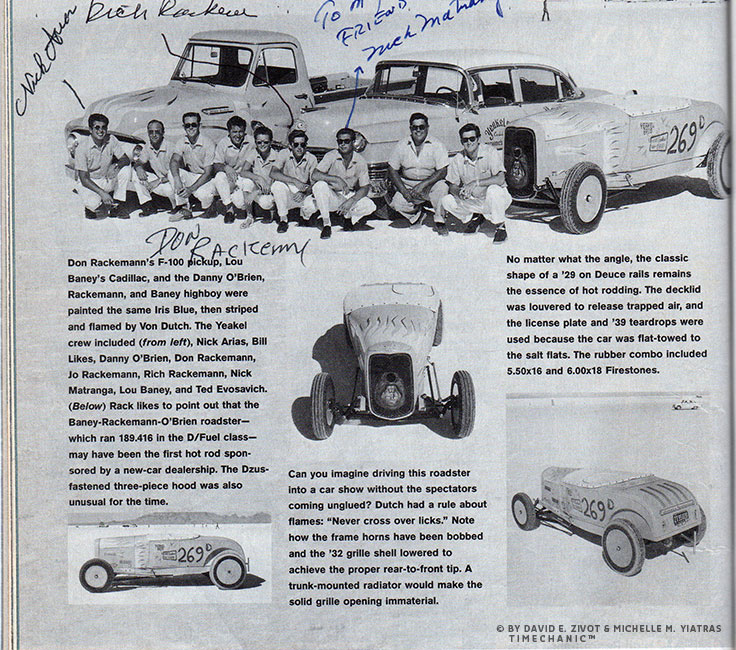 Nick & Yeakel Crew Autographed Aug 2001 Rod & Custom. As personally autographed from Nick & the guys to Dennis Loehr, gifted to David & Michelle.
Nick & Yeakel Crew Autographed Aug 2001 Rod & Custom. As personally autographed from Nick & the guys to Dennis Loehr, gifted to David & Michelle.
[divider]
Inspecting a blurry ghost I titled ‘Drag Races 1956’ from Nick’s personal photo collection, Don comments, “Fran Hernandez was a drag race icon. At the beginning was three or four people that made the dual and three and four carb manifolds for the Ford flathead. The most popular was Edelbrock (my first was a two carb), and the first I ever saw was Eddie Meyer. Just after the War, Fran H. and Fred Offenhauser (nephew of Offy Indy engines) made a deal for Fran’s designs of a set of heads and manifolds. Fran was the machinist, and was promised 25%. Fran got the idea that the Offenhauser name carried weight. He was young and without paperwork, it wasn’t called a ‘Fran’, it was called an ‘Offenhauser’. Fran’s designs were very popular and sales were great. A few years later Fred told Fran he wasn’t getting his 25%. When Vic Edelbrock heard Fran was leaving Offy, he offered and hired him on the spot. When Fran came over to Edelbrock in 1949, the cemented guys, Bobby Meeks and Don Towle, got a little bent out of shape. Because when Fran came in he was a made dude, because he was so smart, and the lead guy in lakes and drag racing. Fran became the main man at Edelbrock. It worked out well.
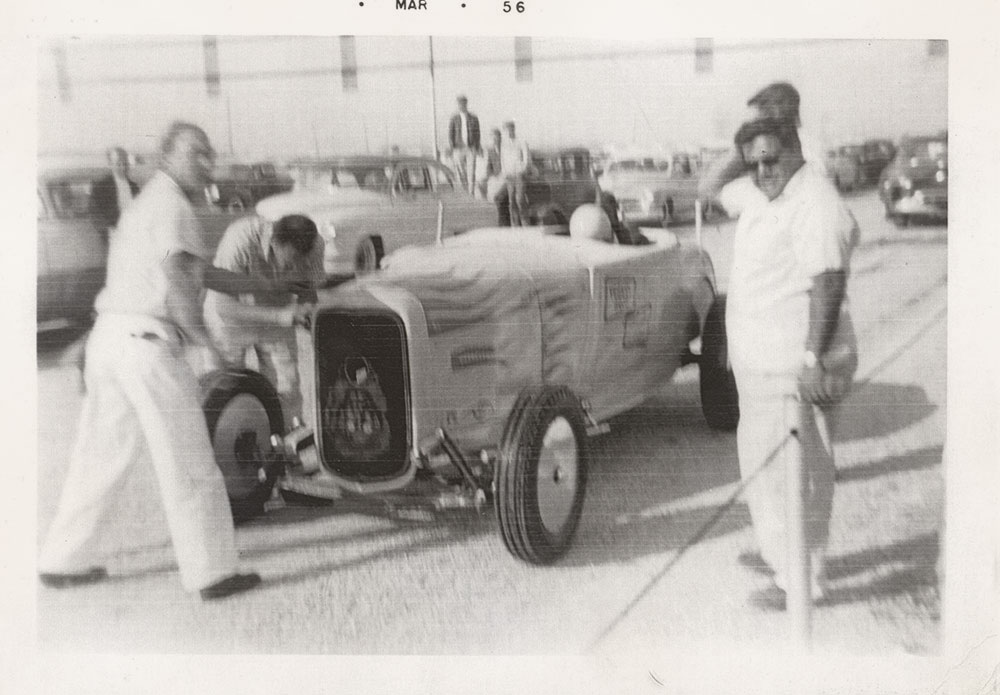 LF. –Bill Likes getting it fired up, LB. –Fran Hernandez legendary hot rod racer and mechanic bending over engine compartment, C. –Don Rackemann driver putting on helmet, RF. –Lou Baney, RB. -Ted Evosavich; from Nick’s personal collection, gifted to David & Michelle.
LF. –Bill Likes getting it fired up, LB. –Fran Hernandez legendary hot rod racer and mechanic bending over engine compartment, C. –Don Rackemann driver putting on helmet, RF. –Lou Baney, RB. -Ted Evosavich; from Nick’s personal collection, gifted to David & Michelle.
[divider]
That’s Danny O’Brien’s ’29 roadster on a ’32 frame with a ’55 Olds Hydra. Fran built the Hydra-Matic we put in that car at the drag strip. Fran did the hydramatic modifications before B & M did, Fran was one of the first, way before. I quit driving the car because it ran very well on gas or alcohol, but when we ran nitro I couldn’t control the transmission, it didn’t have enough stall speed. Even though we had the record at seven drag strips, we never lost. Fran was working on solving that. Fran was liked by everyone. Very abrupt and so bright, everyone wanted him to tell them what to do. He knew everything. An extra good guy that everyone loved.”
 L.-R. –Rich Rackemann, Don Rackemann, Nick Matranga; as taken by Dennis Loehr in Nick’s office at Advanced Transmission.
L.-R. –Rich Rackemann, Don Rackemann, Nick Matranga; as taken by Dennis Loehr in Nick’s office at Advanced Transmission.
[divider]
Rich Rackemann of San Pedro, CA, on Nick
Don’s younger brother, a partner and executive of automotive marketing, advertising, and promotions, for ‘Beaumont Design Group’. “I was a tag along. My brother and Nick were eight years older and brought me with them. I started hanging out when I was 12-13. Started going to drag racing, Bonneville, the lakes, all that. Nick grew up a little more affluent than the rest. His folks owned the Italian restaurant. Some of the guys went in the kitchen to eat. Nick always had nice equipment, all his stuff was very detailed. The way he dressed, carried himself, his hair, his cars, that was very important. He goes and buys a ’40 Merc, the club coupe. His Mother said it was the ugliest car she had ever seen! He told her, ‘Ma, I have a vision. Then it will be the most beautiful car you ever seen!’ And he worked on the Merc and when it was done she agreed with him, ‘Nick, it IS the most beautiful car I have ever seen!’ He’d say, ‘Richie, it’s all in the top, the way the top chop was cut and fitted. The other guys always get that wrong, and the bumper guards in the back placed wrong. Heck, they even get the color wrong.’ He said he was enjoying himself working on the last car because the guy’s (David) head is in the right direction. Junior Conway and I went to Lynwood High School together, same grade Class of 1957. In 1955-56, Nick was building a ’41 Ford pickup at Bob Grossie’s garage on 48th St, L.A., a very nice truck with a very hot Cadillac motor. Just finished it. I told him I had a date and needed a nice set of wheels to go out in. I had the date, and also had a street drag race set up. He said, ‘Sure, come and get it.’ When I got the truck his parting words to me, ‘Richie, don’t break it!’ I told him I’d bring it back sometime Saturday at Grossie’s. Which I did, on the back of a tow truck. His only comment was, ‘Did you win?’ And I said ‘Yes, three times.’
In 1981-82, before he started the black ’32 Ford coupe, he had a line on getting the car. I had built a chopped ’32 Tudor sedan, and I finished the car and was really proud of it, and wanted to take it over to show him. He had been very busy building his business, ‘Crown Transmission’ (before ‘Advanced Transmission’) on Redondo Beach Blvd in Gardena, CA. When I took the car to him, he was very impressed, and very jazzed about getting and building another car. And just after that, the gentleman who had the ’32 coupe passed away, and the wife called Nick and asked if he still wanted the car. He immediately went and got it and started to build it. My ’32 gave him the press to get his, and make it so nice.
In 1955 we went to Bonneville. He had built a Cad motor. We put it in a ’29 hi-boy roadster on ’32 rails. Lou Baney, Don Rackemann, Danny O’Brien, owned and rebuilt the car in 1954. We were gonna run it in three different classes. We had two Cad motors, one owned by Nick, one by Lou Baney. The other built and owned by Nick Arias Jr was a GMC 302 ci 6-cylinder motor. That car won ‘Best Appearing Car and Crew’ at Bonneville, Aug 1955. Hot Rod Magazine published a great pic of the car and crew. The paint, the dress, all the support vehicles (Don Rackemann’s F-100 pickup, Lou Baney’s Cadillac, + the Baney-Rackemann-O’Brien roadster, was considered a rock-around-the-clock lakes, salt, strip, and street quadruple threat!) matched. Theme color ‘Iris’ (light blue iris) with Von Dutch flames and custom pinstriping and painting was Don Rackemann’s idea. Our uniform was white narrow legged pegger pants, special short-sleeved bowling shirts made ‘Iris’ color with the sponsors names (Yeakel Bros Cadillac). Nick always treated me with respect and as an older brother. I was part of their group event though I was younger. Frank Pisano and I were younger, we were the tag alongs.”
 Lined-up at a California Hot Rod show.
Lined-up at a California Hot Rod show.
[divider]
Continue reading about Nick Matranga in the NEXT PART

Go back to part ONE
.
![]()

